

Which is better? Forged Valves & Casting Valves. Castings are one of the most common methods for manufacturing long-lasting and high-quality parts.
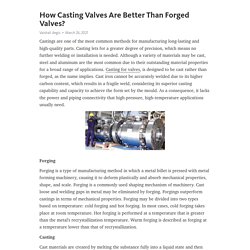
Casting lets for a greater degree of precision, which means no further welding or installation is needed. Although a variety of materials may be cast, steel and aluminum are the most common due to their outstanding material properties for a broad range of applications. Casting for valves, is designed to be cast rather than forged, as the name implies. Cast iron cannot be accurately welded due to its higher carbon content, which results in a fragile weld, considering its superior casting capability and capacity to achieve the form set by the mould. As a consequence, it lacks the power and piping connectivity that high-pressure, high-temperature applications usually need. Forging. Key uses and features of clear cast polyester resin. Polyester resin concrete toppings, which work similarly to form a continuous toppings, were used, however, as previously stated, polyester systems appear to deform, and shrinkage stresses with polyester resin systems may occur at the interfaces among the topping and the concrete substrate if not carefully formulated and laid.
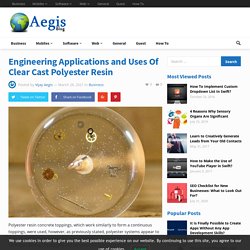
This, along with the increased issues posed by the variations in their factors of thermal enlargement, will lead to failure at the concrete substrate’s edge. Cast objects such as pearl keys, knife and umbrella handles, and extensibility of accompanying sections are only a handful of the essential items produced with clear cast polyester resins. For the manufacturing of bathroom fixtures, polyester compounds have been produced. Floor tiles are made by combining UP resin with additives such as granite, silica, clay, and other natural materials. Which pattern is used in investment casting? Investment casting is indeed a method of machining where a water droplet, also known as correct casting or lost-wax casting, is being used to shape a reusable clay mold.
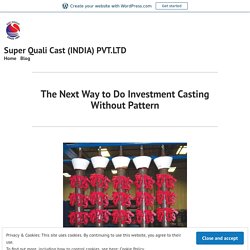
In the same form of product that is also to be cast, a wax design is made. This pattern is painted with an adjunctive ceramic content. How the Investment Casting Process works? What is the investment casting process?
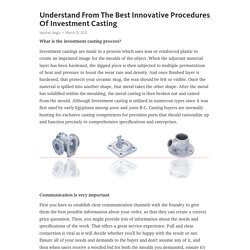
Investment castings are made in a process which uses wax or reinforced plastic to create an imprinted image for the moulds of the object. When the adjuvant material layer has been hardened, the dipped piece is then subjected to multiple permutations of heat and pressure to boost the wear rate and density. And once finished layer is hardened, that protects your ceramic mug, the wax should be felt or visible. Once the material is spilled into another shape, that metal takes the other shape. After the metal has solidified within the moulding, the metal casting is then broken out and casted from the mould. Communication is very important First you have to establish clear communication channels with the foundry to give them the best possible information about your order, so that they can create a correct price quotation.
Give Directions for Reading By casting, a pattern is very closely patterned using the mould with an object to be cast. Scalability & strength properties of Casting valves. What are the main materials used for making the investment casting? The foundry business has been under attack throughout the previous 10 years, possibly more.
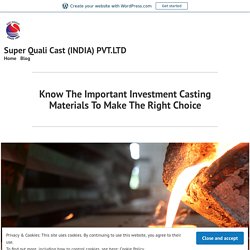
Truth be told, here in Philadelphia, during the 60’s there were at any rate 30 significant foundries. Presently there is just one significant maker. Be that as it may, the projecting cycle is developing on a worldwide premise. Investment Casting: A Manufacturing Process for several years. Technology is everywhere now and then but when it comes to one of the most basic industrial methods, the procedure has remained the same for hundreds or tens of thousands of years.
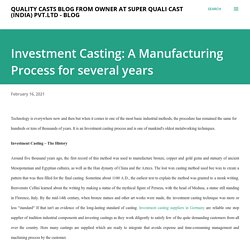
It is an Investment casting process and is one of mankind's oldest metalworking techniques. Investment Casting – The History Around five thousand years ago, the first record of this method was used to manufacture bronze, copper and gold gems and statuary of ancient Mesopotamian and Egyptian cultures, as well as the Han dynasty of China and the Aztecs. The lost wax casting method used bee wax to create a pattern that was then filled for the final casting. Sometime about 1100 A.D., the earliest text to explain the method was granted to a monk writing.
Complete guide to stainless steel application & benefits. Stainless Steel is a component of outstanding mechanical characteristics and is available in a wide range of grades.

Certain grades of stainless steel have the added advantage of excellent corrosion resistance and some grades are heat treatable which further enhances mechanical and carrot resistance characteristics. These are just a few of the reasons why stainless steels are used today to produce a wide variety of casting materials for commercial and industrial investments. Stainless steel investment castings manufacturers has considerable experience in the manufacture of investment casts in different shapes and sizes from a wide range of stainless steel alloys.
Casting in Stainless Steel – What’s it made of? Chromium, nickel and molybdenum (or “moly”) are the base alloy materials for both nickel base and stainless steel casts. Stainless steel is 10.5% less chromium, making it more resistant to corrosive fluid and oxidation conditions. Investment capacity in Stainless Steel. What is the use of cast aluminum? Aluminum casting is one of the common casting processes which involves the liquid metal to be poured into a mold or form.
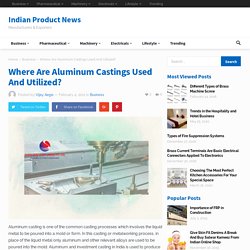
In this casting or metalworking process, in place of the liquid metal only aluminum and other relevant alloys are used to be poured into the mold. Aluminum and investment casting in India is used to produce complex and intricate parts in an efficient manner. What are some of the attractive features of investing casting? There are many types of valves such as butterfly valves, gate valves, check valves, ball valves, control valves and many more which are used in industrial and domestic piping applications.
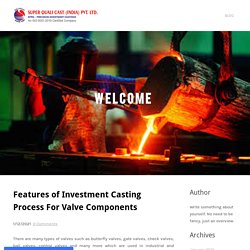
The components of valves such as body, bonnet, flange and disc are manufactured using casting process. Almost all metals can be casted into valve components. Stainless steel, carbon steel and other carbon alloys are also widely casted into valve components. There are many types of casting process. Here we will discuss about Lost Wax or investments castings for valves.